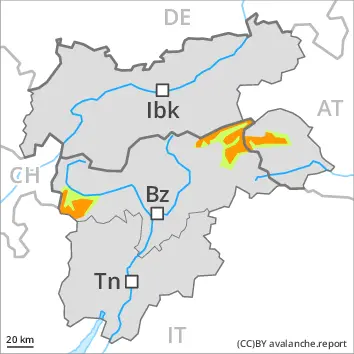Dangerrating 3 – Considerable

2200 m
Tendency: Danger avalanche decreases
am 3. April 2025
am 3. April 2025
2200 m
Snowpack stability:
Poor
Frequency:
Many
Avalanche size:
Medium
2200 m
Snowpack stability:
Poor
Frequency:
Some
Avalanche size:
Medium
Wind slabs and weakly bonded old snow represent the main danger.
Snowpack Structure Highlights
- Danger Patterns
- loose snow and wind
- buried graupel
In some regions up to 40 cm of snow has fallen. As a consequence of new snow and strong wind the wind slabs have increased in size additionally. The new snow and wind slabs are lying on soft layers in particular on steep shady slopes above approximately 2200 m.
Avalanche prone weak layers exist in the old snowpack especially on little used west, north and east facing slopes. This applies on shady slopes above approximately 2200 m, as well as on west and east facing slopes above approximately 2600 m.
Gradual decrease in avalanche danger.
As a consequence of new snow and a sometimes storm force wind from northeasterly directions, avalanche prone wind slabs formed in the last few days in particular adjacent to ridgelines and in gullies and bowls. These can be released by a single winter sport participant. Caution is to be exercised in particular on steep slopes above approximately 2200 m. As a consequence of the solar radiation, the likelihood of slab avalanches being released will increase in particular on steep sunny slopes.
Weak layers in the upper part of the snowpack can be released by individual winter sport participants. These avalanche prone locations are to be found in particular on steep, little used shady slopes above approximately 2200 m and on steep, little used west and east facing slopes above approximately 2600 m. In isolated cases avalanches can also release deeper layers of the snowpack. Mostly avalanches are medium-sized.
As a consequence of warming during the day and solar radiation more frequent loose snow avalanches are to be expected, even medium-sized ones, in the regions exposed to a lot of new snow in particular on extremely steep slopes.
Individual gliding avalanches can also occur. This applies on steep grassy slopes below approximately 2400 m.